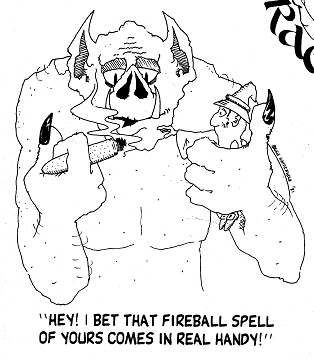Fireball
(Evocation)

Fireball
(Evocation)

|
|
|
|
|
|
|
|
|
|
|
|
|
|
|
|
|
|
** Damage <Mega-damage>
shown is per level of the spell caster employing the spell, and
assumes fire damage following;
if the wooden TARGET is protected by
green
hides, is wet, etc., reduce damage by 50%.
Area: The burst of
the fireball does not expend a considerable amount of pressure,
and the burst will generally
conform to the shape of the AREA in which it occurs,
thus covering an AREA =equal=
to its normal spherical volume.
[The AREA which is covered
by the fireball is a total volume of roughly 33,000 cubic feet].
Saving
Throw: If creatures fail their saves, they all take full HP
damage from the blast. <(Fire Damage)>
Those who make saves manage
to dodge, fall flat or roll aside, taking 1/2 the full HP
damage
-- each and every one within
the blast AREA.
Effect: A fireball
is an explosive burst of flame, which detonates with a low roar,
and delivers damage proportionate
to the level of the M-U who CAST it,
i.e. 1 six-sided die (d6)
for each level of xperience of the spell caster.
Besides causing damage
to creatures,
the fireball ignites all
combustible materials within its burst radius,
and the heat of the fireball
will melt soft metals such as gold, copper,
silver,
etc.
Items exposed to the spell's
effects must be rolled for to determine if they are affected.
Items with a creature which
makes its save are considered as unaffected.
The M-U points his or her
finger and speaks the range (distance and height) at which the fireball
is to burst.
A streak flashes from the
pointing digit and, unless it impacts upon a material body prior to attaining
the prescribed range,
flowers into the fireball.
Effect.exception:
Magic fireball wands deliver 6 die fireballs (6d6),
magic staves with this capability
deliver 8 die fireballs,
and scroll spells of this
type deliver a fireball of from 5 to 10 dice (d6 + 4) of damage.
MC: A tiny ball composed of batshit && sulphur. <>
*
can be CAST and will function within the bounds of an airy
water spell.
Q: Does the AD&D
game's third-level, M-U spell fireball get larger
outdoors?
That is, does the size of
the fireball convert from feet to yards outdoors?
Page 73 of the PH
seems to indicate that this is the case.
A: The area of effect
of all AD&D game
spells remains the same
outdoors as
indoors (1" = 10´),
but the range of the
spells increases, from 1"
= 10' indoors to
1" = 10 yards (30') outdoors.
The reference
to "yards" in the spells
description is
completely in error.
(127.67)
Q: Would a magic-user
take damage
from his own fireball if
the spell
were cast at zero range?
A: Absolutely yes!
Note that a fireball has a
cubic volume in excess of
33,000 cubic
feet, enough to fill about
335' of 10' x 10'
corridor. A mage doesn't
have to cast a
fireball at range zero in
order to get
caught in the blast.
(139.66)

Q: The rules say a
fireball detonates
at a point designated by
the caster
or when it strikes a solid
object.
What is the chance of an
archer hitting
the fireball with an arrow
and
causing it to detonate while
in
flight?
A, Shooting down a fireball:
I repeated
this question to one of
my regular playing
groups and got in return
five bemused
grins and the following
straight-faced
comment: "Gee, you" ll also
need rules for
[shooting down fireballs
with] magic missiles
and things like that, too.?
For the
record, hitting a fireball
or similar missile
with another missile, magical
or not, is
about as likely as every
creature on a
world taking a step at the
same instant,
thereby creating cataclysmic
vibrations
that shake the planet apart.
That is, it's
possible in theory but gosh
darn well near
impossible in practice.
(156.55)
